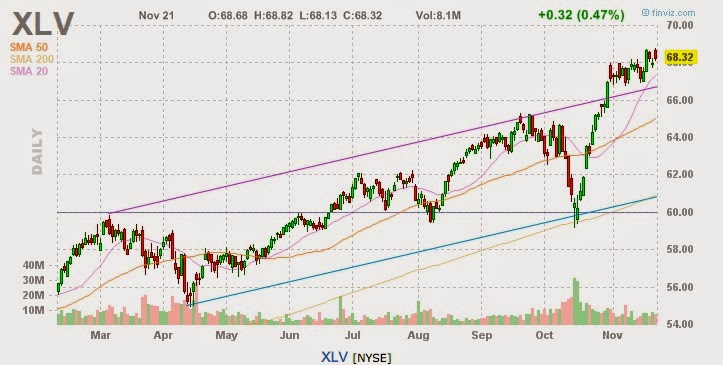So eventually we want to buy health sector fund AND a discretionary sector fund, but in the name of making a decision we are arbitrarily we are going to look health ETFs.
If you go to FinViz and you take a look at XLV, you'll see an interesting trend:
The purple line represents the psychological ceiling of the fund and the blue line shows the floor.
If we wanted to buy something and were looking for a good in, this trend could indicate that the market will "allow" the stock to keep climbing.
XLY has not broken the psychological ceiling yet:
This comparison shows how short-term volatility can play a role in choosing to get into an investment. XLY hasn't cracked that psychological barrier, whereas XLV has. These lines represent a long-term trend, and the short-term volatility seems to be responding to the logic that these long-term trends are establishing. In other words, the long-term trend makes the market "want" to adhere to the long-term trend, sort of like a self-fulfilling prophecy. Isn't it funny low logical that doesn't sound?
As a side note, adding either of these funds would definitely increase the beta (volatility) of our portfolio.
Of course, words like short and long term are definitely relative. Our investment strategy loosely defines short term as a a few weeks and long term as several months or more. On the other hand, a day trader might be looking at short and long term being hours vs. days, and a Skynet investment computer is looking at nano- vs. mini- seconds. Who wants to start stockpiling gold?
XLY and XLV are the iShares Spider ETFs for discretionary and health, respectively. In the past the Vanguard versions of these, because we've noticed Vanguard tends to have lower expense ratios, but it looks like the dividend yield for the Spider ETFs more than makes up for the minor differences in expense ratios. If you take a look at the values for each, you will notice that they are more or less the same.
 |
| VHT vs. XLV |
This means that questions of expense ratio, dividend yield, and volume will influence us to go with one as opposed to the other.
As an aside, it makes sense that VHT and XLV are about the same, since they both track the sector. Each fund is actively managed, so there are some differences in the makeup of each.
So we're a bit torn between one or the other, and we can't really see much difference between the two. OUr $500 buy increment made the decision for us, since VHTs $125 a share price fits nicely in.
Who said it was hard to make decisions.
Profit



No comments:
Post a Comment